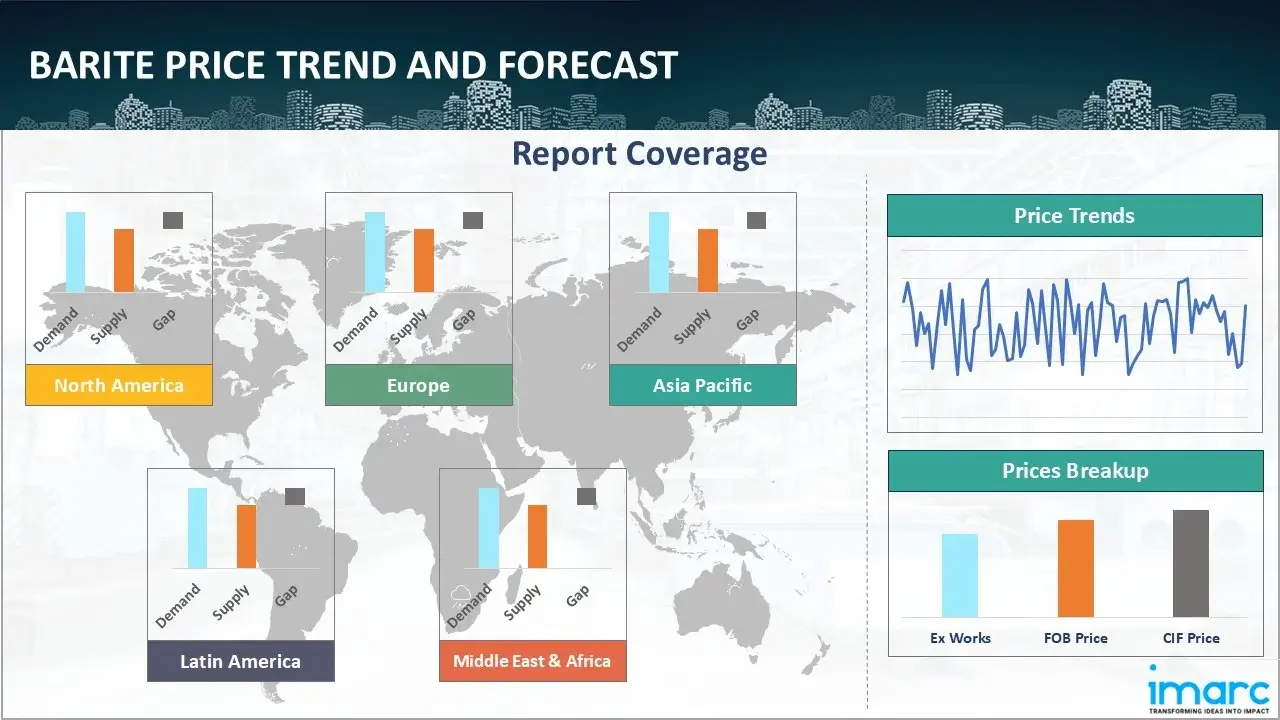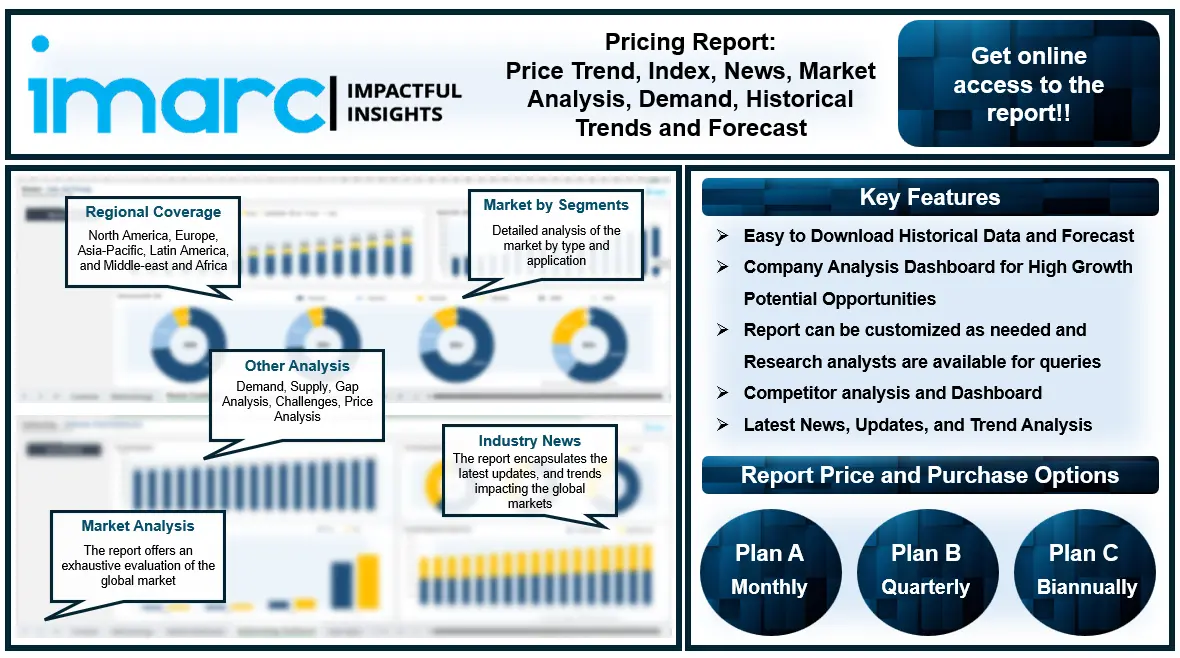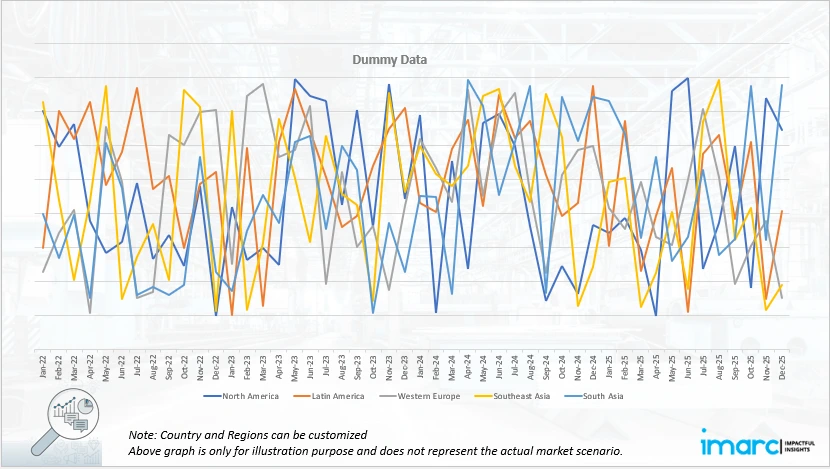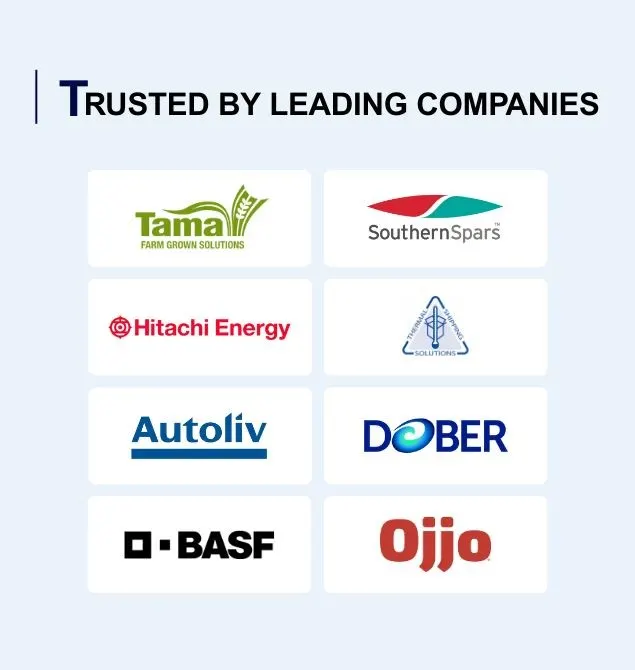
Barite Prices, Trend, Chart, Demand, Market Analysis, News, Historical and Forecast Data Report 2025 Edition
Barite Price Trend, Index and Forecast
Track the latest insights on Barite price trend and forecast with detailed analysis of regional fluctuations and market dynamics across North America, Latin America, Central Europe, Western Europe, Eastern Europe, Middle East, North Africa, West Africa, Central and Southern Africa, Central Asia, Southeast Asia, South Asia, East Asia, and Oceania.
Barite Prices Outlook Q3 2025
- USA: USD 160/MT
- Europe: USD 455/MT
- Japan: USD 300/MT
- Brazil: USD 348/MT
Barite Price Chart
Get real-time access to monthly/quarterly/yearly prices Request Sample
During the third quarter of 2025, the barite prices in the USA reached 160 USD/MT in September. The market saw moderate growth due to sustained demand from the oil and gas drilling sector. Domestic mining operations faced higher extraction costs, while transportation bottlenecks increased freight rates. Rising exploration activity in shale-rich regions supported consumption levels, although sluggish construction demand provided limited offset to overall market gains.
During the third quarter of 2025, the barite prices in Europe reached 455 USD/MT in September. Prices were driven by stable consumption from the drilling mud and chemical sectors. Energy costs and tight supply from Morocco and China impacted import expenses. European producers benefited from firm downstream demand in the North Sea drilling operations, though environmental regulations continued to restrict local production activities.
During the third quarter of 2025, the barite prices in Japan reached 300 USD/MT in September. Prices were supported by consistent demand from the paints and coatings sector. Import dependency, combined with currency fluctuations, elevated landed costs. Supply tightness from key exporters such as China and India further influenced pricing, while moderate growth in domestic manufacturing activities sustained overall consumption levels.
During the third quarter of 2025, the barite prices in Brazil reached 348 USD/MT in September. Pricing was shaped by steady requirements from the oil and gas exploration sector. Domestic supply constraints and longer shipping lead times from global exporters influenced overall costs. Stable industrial activity and higher operational expenses in domestic mines added pressure to pricing during this quarter.
Barite Prices Outlook Q2 2025
- USA: USD 157/MT
- Europe: USD 450/MT
- Japan: USD 293/MT
- Brazil: USD 340/MT
During the second quarter of 2025, the barite prices in the USA reached 157 USD/MT in June. The market experienced steady price performance supported by consistent drilling activity in key shale basins. Moderate increases in production costs due to labor and fuel expenses slightly affected margins. A stable import flow and sufficient domestic supply maintained price equilibrium across major consuming regions.
During the second quarter of 2025, the barite prices in Europe reached 450 USD/MT in June. Market sentiment was stable as procurement from major oilfield service providers remained consistent. Limited domestic output and higher transportation costs from African and Asian suppliers contributed to firm price levels. Refinery and construction sector demand continued to provide steady offtake in the region.
During the second quarter of 2025, the barite prices in Japan reached 293 USD/MT in June. Barite demand remained healthy, particularly from industrial applications like paint fillers and friction materials. Import dependency and foreign exchange volatility continued to shape pricing dynamics. Availability of premium-grade ore was slightly constrained due to export delays from key supplier countries.
During the second quarter of 2025, the barite prices in Brazil reached 340 USD/MT in June. Prices remained firm as domestic production was restricted by weather-related mining challenges. Import volumes from China increased to balance supply shortages. Sustained demand from offshore drilling operations maintained market stability despite moderate logistical inefficiencies at major ports.
Barite Prices Outlook Q1 2025
- India: USD 150/MT
- UAE: USD 186/MT
- Brazil: USD 157/MT
During the first quarter of 2025, the barite prices in India reached 150 USD/MT in March. Supply chain disruptions, rising freight costs, and increased production costs for manufacturers contributed to price volatility. Demand from the oil and gas industry, paints and coatings, and plastics sectors also played a role, with fluctuations in these industries impacting barite usage.
During the first quarter of 2025, the barite prices in the UAE reached 186 USD/MT in March. As per the barite price chart, due to a combination of supply and demand, the market saw a significant price hike in January. Demand for the mineral was greatly increased by the UAE's burgeoning oil drilling industry and the Middle East's record-high offshore rig utilization. Meanwhile, rising freight costs brought on by Red Sea geopolitical tensions led to supply shortages.
During the first quarter of 2025, the barite prices in Brazil reached 157 USD/MT in March. Plastics, paints, and rubber industries rely on barite as a filler material, and their increasing demand for these products contributed to the changes in barite prices.

Regional Coverage
The report provides a detailed analysis of the market across different regions, each with unique pricing dynamics influenced by localized market conditions, supply chain intricacies, and geopolitical factors. This includes price trends, price forecast and supply and demand trends for each region, along with spot prices by major ports. The report also provides coverage of FOB and CIF prices, as well as the key factors influencing the barite prices.
Europe Barite Price Trend
Q3 2025:
As per the barite price index, in Europe, barite prices were shaped by high import costs from major suppliers such as Morocco and China. Drilling demand in offshore energy projects sustained consumption levels. Elevated electricity and fuel prices increased overall processing and logistics costs. Environmental restrictions on local extraction activities also contributed to a constrained regional supply scenario.
Q2 2025:
As per the barite price index, European prices displayed a stable to firm trajectory. Continuous requirements from the oil and gas sector ensured steady offtake. Rising energy tariffs and higher maritime shipping charges affected the landed cost of imports. Moderate seasonal demand from industrial fillers and coatings applications maintained market balance across the region.
Q1 2025:
As per the barite price index, prices in Europe were influenced by a combination of factors, including fluctuations in oil and gas drilling activities, global supply chain disruptions, and seasonal demand patterns. The oil and gas industry's reliance on barite as a weighting agent in drilling fluids, along with the impact of geopolitical tensions and global economic conditions, further contributed to price volatility.
This analysis can be extended to include detailed barite price information for a comprehensive list of countries.
| Region | Countries Covered |
|---|---|
| Europe | Germany, France, United Kingdom, Italy, Spain, Russia, Turkey, Netherlands, Poland, Sweden, Belgium, Austria, Ireland, Switzerland, Norway, Denmark, Romania, Finland, Czech Republic, Portugal, and Greece, among other European countries. |
North America Barite Price Trend
Q3 2025:
As per the barite price index, in North America, prices were supported by rising exploration and drilling activities in shale-rich basins. Supply disruptions caused by maintenance shutdowns at key processing plants tightened regional availability. Transportation bottlenecks and fuel cost escalations added to operational expenses. The oilfield services sector remained the primary consumer, sustaining steady price movements.
Q2 2025:
The North American market maintained stable pricing momentum, with balanced supply and demand conditions. Moderate inventory levels and continuous exploration in the Gulf Coast supported procurement volumes. Stable domestic output prevented significant price fluctuations. A gradual increase in energy input costs led to controlled upward price adjustments by major suppliers.
Q1 2025:
The availability of barite was restricted by supply chain disruptions, including decreased mining efficiency and logistical congestion at important ports. Besides, the total price and accessibility of barite were further affected by rising freight expenses. Moreover, investment in the oil and gas sector, driven by factors like rising oil prices, further influenced barite demand and price.
Specific barite historical data within the United States and Canada can also be provided.
| Region | Countries Covered |
|---|---|
| North America | United States and Canada |
Middle East and Africa Barite Price Trend
Q3 2025:
As per barite price chart, the prices in the Middle East and Africa fluctuated due to a complex interplay of factors, primarily driven by supply chain disruptions, seasonal demand shifts, and geopolitical influences.
Q2 2025:
The report explores the barite pricing trends and barite price chart in the Middle East and Africa, considering factors like regional industrial growth, the availability of natural resources, and geopolitical tensions that uniquely influence market prices.
Q1 2025:
As per the barite price chart, due to a combination of supply and demand, the barite market saw a significant price hike in January. Demand was greatly elevated by the UAE's burgeoning oil drilling industry and the Middle East's record-high offshore rig utilization. Meanwhile, disruptions in India's barite production and rising freight costs brought on by Red Sea geopolitical tensions led to supply shortages. Barite prices increased as a result of these combined forces, reflecting the changing dynamics of the global logistics and energy industries.
In addition to region-wise data, information on barite prices for countries can also be provided.
| Region | Countries Covered |
|---|---|
| Middle East & Africa | Saudi Arabia, UAE, Israel, Iran, South Africa, Nigeria, Oman, Kuwait, Qatar, Iraq, Egypt, Algeria, and Morocco, among other Middle Eastern and African countries. |
Asia Pacific Barite Price Trend
Q3 2025:
In the Asia Pacific region, barite prices were influenced by steady demand from oilfield, chemical, and paint industries. China’s supply restrictions due to mine inspections and export limitations affected availability across importing nations. Currency fluctuations and elevated freight rates further added to regional pricing pressure.
Q2 2025:
The Asia Pacific barite market saw stable pricing as producers adjusted output to align with moderate demand. Improved mining performance in India and China balanced earlier supply constraints. Industrial consumption in paints and plastics sectors supported steady procurement, while logistical conditions remained relatively stable throughout the quarter.
Q1 2025:
In January, a white barite mine lease in Andhra Pradesh was suspended, potentially disrupting India's supply of barite. This lease sparked questions about anomalies as it was given without sufficient administrative examination. Moreover, as barite is essential to many industries, such as paints and oil and gas drilling, the mine's production halt affected the availability of the material domestically, thus impacting prices.
This barite price analysis can be expanded to include a comprehensive list of countries within the region.
| Region | Countries Covered |
|---|---|
| Asia Pacific | China, India, Indonesia, Pakistan, Bangladesh, Japan, Philippines, Vietnam, Thailand, South Korea, Malaysia, Nepal, Taiwan, Sri Lanka, Hongkong, Singapore, Australia, and New Zealand, among other Asian countries. |
Latin America Barite Price Trend
Q3 2025:
In Latin America, barite prices increased moderately owing to steady demand from the oil exploration sector in Brazil and Argentina. High import reliance, currency weakness, and port delays continued to elevate logistics expenses. Consistent consumption from the paints and filler industries provided stability to market performance.
Q2 2025:
Market prices remained firm in Latin America as offshore drilling operations maintained continuous offtake. Domestic mining output was limited, necessitating additional imports from China. Inflationary trends and transportation inefficiencies exerted mild upward pressure on regional pricing levels during the quarter.
Q1 2025:
As seen in the barite price index, the market witnessed price fluctuations. Barite is used in various industries like paints, plastics, and rubber, and growth in these sectors contributes to overall demand. Besides, logistical challenges, rising freight costs, and disruptions in the supply chain affected the availability and price of barite in Latin America, which relies on international trade.
This comprehensive review can be extended to include specific countries within the region.
| Region | Countries Covered |
|---|---|
| Latin America | Brazil, Mexico, Argentina, Columbia, Chile, Ecuador, and Peru, among other Latin American countries. |
Barite Price Trend, Market Analysis, and News
IMARC's latest publication, “Barite Prices, Trend, Chart, Demand, Market Analysis, News, Historical and Forecast Data Report 2025 Edition,” presents a detailed examination of the barite market, providing insights into both global and regional trends that are shaping prices. This report delves into the spot price of barite at major ports and analyzes the composition of prices, including FOB and CIF terms. It also presents detailed barite prices trend analysis by region, covering North America, Europe, Asia Pacific, Latin America, and Middle East and Africa. The factors affecting barite pricing, such as the dynamics of supply and demand, geopolitical influences, and sector-specific developments, are thoroughly explored. This comprehensive report helps stakeholders stay informed with the latest market news, regulatory updates, and technological progress, facilitating informed strategic decision-making and forecasting.

Barite Industry Analysis
The global barite industry size reached USD 1.97 Billion in 2024. By 2033, IMARC Group expects the market to reach USD 2.76 Billion, at a projected CAGR of 3.61% during 2025-2033.Rising exploration and drilling activities in the oil and gas industry are the key factors driving the market. Growing use of barite in paints, plastics, and rubber applications, coupled with consistent demand from the medical and electronics sectors, further supports global market expansion.
Latest developments in the barite industry:
- January 2025: Voyageur Pharmaceuticals Ltd. announced the company’s remarkable milestones in a news release titled “Voyageur Recaps Significant 2024 Achievements and Unveils Plans for Transformational 2025. The highlights included five new Health Canada-licensed barium contrast products.
- April 2024: The Andhra Pradesh Mineral Development Corporation (APMDC) submitted the tender document for the selection of a joint venture partner for planning, engineering, financing, construction, development, operation-cum-maintenance of an integrated iron ore project in the state to the AP Judicial Preview Commission.
- July 2023: Vishnu Chemicals a specialty chemical manufacturer based in Hyderabad fully acquired Ramadas Minerals Pvt Ltd a company located in Chennai through its wholly-owned subsidiary Vishnu Barium Pvt Ltd. Ramadas Minerals specializes in the beneficiation of Baryte ores and is recognized for its advanced beneficiation plant that utilizes US-patented technology to eliminate impurities and produce a higher-grade Barium.
- May 2023: The Nigerian Federal Government announced its plans to foster the development of downstream barite mining industries by setting up a processing plant in Ugaga located in the Yala local government area of Cross River State an area noted for its substantial barite reserves.
- October 2022: Newpark Resources, Inc. completed a transaction to transfer nearly all assets, inventory and operations of its Excalibar mineral grinding division to Cimbar Resources, Inc., a company based in Chatsworth, GA, that focuses on mineral-based additives. As of September 30, 2022, Excalibar reported approximately $65 million in net capital employed. This agreement is anticipated to generate around $66 million in net cash for Newpark, sourced from a combination of cash received at closing and net collections from specific retained assets and liabilities. Additionally, Cimbar and Newpark have established a long-term supply contract for barite to support Newpark's U.S. drilling fluids division.
- May 2022: The Andhra Pradesh Mineral Development Corporation (APMDC) has shifted its focus to the U.S. market after signing Memoranda of Understanding (MoUs) valued at USD 90 million to supply 1.6 million metric tons of baryte to three American companies.
Product Description
Barite (BaSO₄), or barium sulfate, is a naturally occurring mineral known for its high specific gravity, chemical inertness, and white coloration. It is typically found in sedimentary rocks and is processed into various grades depending on purity and particle size. Barite’s primary industrial use lies in drilling mud formulations for oil and gas exploration, where it acts as a weighting agent to control well pressure.
Beyond its dominant role in drilling fluids, barite is also utilized in producing paints, plastics, and rubber products as a filler to enhance brightness and density. In the medical sector, it serves as a radiopaque agent in X-ray imaging. Additionally, barite is used in glass manufacturing, chemical production of barium compounds, and soundproofing materials. Its chemical stability, non-reactivity, and high density make it a versatile material across multiple industrial applications.
Report Coverage
| Key Attributes | Details |
|---|---|
| Product Name | Barite |
| Report Features | Exploration of Historical Trends and Market Outlook, Industry Demand, Industry Supply, Gap Analysis, Challenges, Barite Price Analysis, and Segment-Wise Assessment. |
| Currency/Units | US$ (Data can also be provided in local currency) or Metric Tons |
| Region/Countries Covered | The current coverage includes analysis at the global and regional levels only. Based on your requirements, we can also customize the report and provide specific information for the following countries: Asia Pacific: China, India, Indonesia, Pakistan, Bangladesh, Japan, Philippines, Vietnam, Thailand, South Korea, Malaysia, Nepal, Taiwan, Sri Lanka, Hongkong, Singapore, Australia, and New Zealand* Europe: Germany, France, United Kingdom, Italy, Spain, Russia, Turkey, Netherlands, Poland, Sweden, Belgium, Austria, Ireland, Switzerland, Norway, Denmark, Romania, Finland, Czech Republic, Portugal and Greece* North America: United States and Canada Latin America: Brazil, Mexico, Argentina, Columbia, Chile, Ecuador, and Peru* Middle East & Africa: Saudi Arabia, UAE, Israel, Iran, South Africa, Nigeria, Oman, Kuwait, Qatar, Iraq, Egypt, Algeria, and Morocco* *The list of countries presented is not exhaustive. Information on additional countries can be provided if required by the client. |
| Information Covered for Key Suppliers |
|
| Customization Scope | The report can be customized as per the requirements of the customer |
| Report Price and Purchase Option |
Plan A: Monthly Updates - Annual Subscription
Plan B: Quarterly Updates - Annual Subscription
Plan C: Biannually Updates - Annual Subscription
|
| Post-Sale Analyst Support | 360-degree analyst support after report delivery |
| Delivery Format | PDF and Excel through email (We can also provide the editable version of the report in PPT/Word format on special request) |
Key Benefits for Stakeholders:
- IMARC’s report presents a detailed analysis of barite pricing, covering global and regional trends, spot prices at key ports, and a breakdown of FOB and CIF prices.
- The study examines factors affecting barite price trend, including input costs, supply-demand shifts, and geopolitical impacts, offering insights for informed decision-making.
- The competitive landscape review equips stakeholders with crucial insights into the latest market news, regulatory changes, and technological advancements, ensuring a well-rounded, strategic overview for forecasting and planning.
- IMARC offers various subscription options, including monthly, quarterly, and biannual updates, allowing clients to stay informed with the latest market trends, ongoing developments, and comprehensive market insights. The barite price charts ensure our clients remain at the forefront of the industry.
Need more help?
- Speak to our experienced analysts for insights on the current market scenarios.
- Include additional segments and countries to customize the report as per your requirement.
- Gain an unparalleled competitive advantage in your domain by understanding how to utilize the report and positively impacting your operations and revenue.
- For further assistance, please connect with our analysts.
Why Choose Us
IMARC offers trustworthy, data-centric insights into commodity pricing and evolving market trends, enabling businesses to make well-informed decisions in areas such as procurement, strategic planning, and investments. With in-depth knowledge spanning more than 1000 commodities and a vast global presence in over 150 countries, we provide tailored, actionable intelligence designed to meet the specific needs of diverse industries and markets.
1000
+Commodities
150
+Countries Covered
3000
+Clients
20
+Industry
Robust Methodologies & Extensive Resources
IMARC delivers precise commodity pricing insights using proven methodologies and a wealth of data to support strategic decision-making.
Subscription-Based Databases
Our extensive databases provide detailed commodity pricing, import-export trade statistics, and shipment-level tracking for comprehensive market analysis.
Primary Research-Driven Insights
Through direct supplier surveys and expert interviews, we gather real-time market data to enhance pricing accuracy and trend forecasting.
Extensive Secondary Research
We analyze industry reports, trade publications, and market studies to offer tailored intelligence and actionable commodity market insights.
Trusted by 3000+ industry leaders worldwide to drive data-backed decisions. From global manufacturers to government agencies, our clients rely on us for accurate pricing, deep market intelligence, and forward-looking insights.

 Request Customization
Request Customization
 Inquire Before Buying
Inquire Before Buying
 Speak to an Analyst
Speak to an Analyst Request Brochure
Request Brochure




.webp)




.webp)












